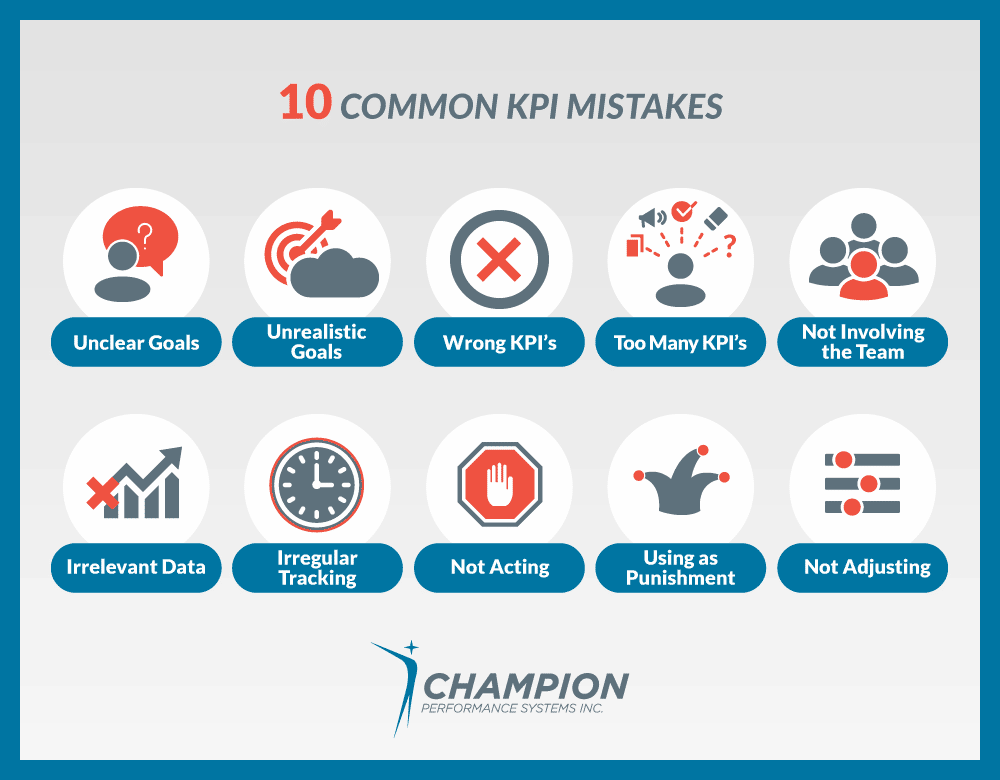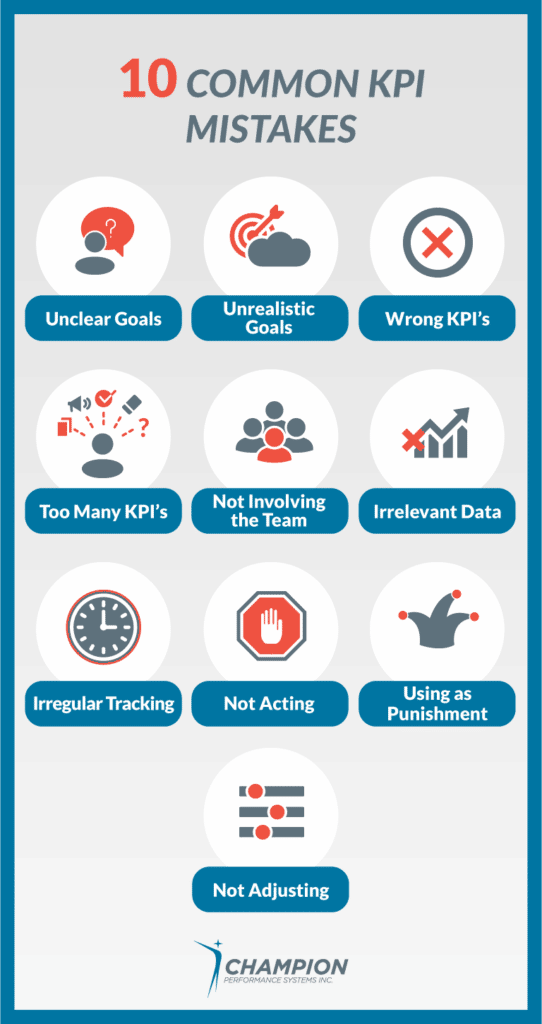You may have heard of KPIs before, as they are commonly used to measure sales performance, operational efficiency, customer satisfaction, and employee retention.
If you’re not already tracking some key performance indicators (KPIs) for your business, now is the time to start. But how do you know which KPI’s are important to track and how to properly observe them?
The selection of KPIs is specific to each organization and depends on its business goals.
In this blog post, we’ll explain the factors to consider, provide tips for choosing the right KPIs, and outline actionable steps for monitoring them.
What is a Key Performance Indicator (KPI)?
A key performance indicator, or KPI, is a business metric used to evaluate success in achieving predetermined organizational goals.
KPIs are often displayed in dashboards or scorecards so that managers and employees can track progress and identify areas needing improvement.
While KPIs can be helpful in gauging organizational success, it is important to remember that they should not be used in isolation. In other words, don’t rely on just one KPI to give you the whole picture. Instead, use multiple KPIs to get a more well-rounded view of how your organization is performing.
What are Some Examples of Common KPI’s?
There are many different types of key performance indicators (KPI’s), but some of the most common high level areas include measures of profitability, productivity, customer satisfaction, and employee satisfaction.
Below are some different types of KPI’s to consider tracking for your business:
- Sales – This is probably the most common KPI. Sales KPIs can include things like total revenue, number of sales, conversion rate, and average order value.
- Marketing – Marketing KPIs can include things like website traffic, social media engagement, and lead generation.
- Customer Service – Customer service KPIs can include things like customer satisfaction, customer retention rate, customer complaints, first contact resolution rate, and Net Promoter Score.
- Finance – Finance KPIs can include things like profitability, cash flow, and return on investment.
- Human Resources – Human resources KPIs can include things like employee turnover rate, absenteeism, number of safety incidents, and training costs.
Many organizations use a combination of different KPI’s to paint a bigger picture of what’s happening with the business.
How Do I Choose the Right KPI’s for My Business?

When determining which KPI’s are important for your business, you need to consider what you want to measure and why. Make sure that the KPIs you choose are achievable and ultimately aligned with your business goals.
Once you’ve identified your company’s goals, you can choose KPI’s that will help you measure progress towards those goals.
Consider what you want to track and what you can realistically monitor—then create KPI’s that can be influenced by the actions of the organization.
For example, If customer satisfaction is a priority, then you would likely select a KPI that tracks customer feedback. If customer feedback is negative, you can use that information to make improvements to your business. Similarly, if you are looking to increase sales, you would want to track a metric like number of sales made or total revenue generated. Then turn around and use that information to set financial goals with your sales team.
How Do I Manage and Track My KPI’s?
It’s not enough to set up KPI’s and then forget about them. By regularly monitoring your KPI’s, you can get a better sense of how your organization is performing, determine if they’re still relevant and accurate, identify areas of improvement, and make adjustments as needed.
Here are some things to think about for setting up a successful tracking plan to get the most out of your KPI’s.
- Frequency – Determine how often you will review your KPI’s. The answer to this question depends on a number of factors, including the nature of your business, the type of KPIs you’re tracking, and how quickly your business is growing or changing. At a minimum, you should consider reviewing your KPIs on a quarterly or monthly basis. However, if your business is growing quickly or undergoing major changes, you may need to review them more often.
- Data – Make sure you’re tracking your KPI’s in a way that makes sense for your business. For example, if you’re tracking website traffic, you might want to look at things like page views, unique visitors, and bounce rate. If you’re tracking sales, you should look at number of sales, total revenue, and conversion rate.
- Systems – There are many different software programs and platforms available for tracking KPIs. Choose a tool that’s easy to use and provides the features you need.
Tracking your KPIs is a critical step in ensuring your business’s success. If you’re not sure how to monitor your KPI’s or how often you should be reviewing them, talk to a business consultant or a trusted advisor. They can help you determine a plan that makes sense.
How Do I Use KPIs to Make Business Decisions?
When used correctly, KPI’s can be a powerful tool for making sound business decisions. By understanding where a company is excelling, and where there is room for improvement, KPI’s can provide valuable insights into how to make better business decisions.
As you start tracking your KPI’s, you’ll begin to see patterns emerge. Perhaps sales increase when you increase your marketing budget. Or maybe customer satisfaction dips when you introduce a new product. These patterns will help you make better decisions about where to allocate your resources.
For example, let’s say your KPI for website traffic is to increase website visitors by 20% every month. However, you find that your website traffic has actually decreased by 5% in the last month. The first step is to identify the root cause of the problem. In this case, the issue could be that your website is not being promoted enough. Once you have identified the cause, you can take steps to fix it. In this case, you could start promoting your website more through informative and SEO driven blogs, online ads, or other channels of promotion.
So if you’re looking to make smarter business decisions, KPI’s are a great place to start. By tracking KPI’s and identifying patterns, you can ensure that your decisions are based on data instead of guesswork.
10 Common Mistakes Businesses Make with KPI’s
KPI’s are essential for measuring progress and determining whether or not a company is on track to meet its goals. However, KPI’s can also be tricky and the process can be confusing and overwhelming if you’re not sure how to use them effectively.
Here are ten common mistakes businesses make with KPI’s:


- Not Setting Clear Goals – KPI’s are only useful if they’re aligned with your overall business goals. Before you start tracking KPI’s, take some time to clarify what you want to achieve. Otherwise, you’ll just be spinning your wheels.
- Setting Unrealistic Goals – While it’s important to set ambitious goals, KPI’s should be achievable. Otherwise, they can demotivate employees and cause frustration. Furthermore, unrealistic KPI’s can lead to bad decision-making in an attempt to meet the goals. This can have a negative impact on the business as a whole. Instead of setting unrealistic KPI’s, businesses should focus on setting achievable goals that will help them measure and improve their performance.
- The Wrong KPIs – Your KPIs should be aligned with your company objectives. They should also be measurable and actionable. If they’re not, then they’re not going to be very helpful in guiding your business decisions.
- Focusing on Too Many KPI’s – It’s important to focus on a few key KPI’s that will really give you insights into your business. Trying to track too many KPI’s can be overwhelming and won’t give you the most accurate picture of your business.
- Not Involving the Entire Team– Employees are the ones who are actually going to be working towards meeting the KPI’s, so it only makes sense to involve them in setting the KPI’s in the first place. Everyone in the company should be aware and understand how their work contributes to them. Otherwise, it’s difficult to get buy-in and achieve results.
- Tracking Irrelevant Data – The data you track should be timely, accurate, and complete. Make sure you’re tracking KPIs that are relevant to your business goals and that will give you the information you need to make decisions and improve your business. If you’re not sure which KPIs to track, talk to a business consultant or advisor who can help you identify the right ones for your business.
- Not Tracking Regularly – As your business grows and changes, new opportunities will arise. Reviewing your KPIs can help you spot these opportunities and take advantage of them. On the flip side, it also gives you a chance to catch problems early and make changes before they become bigger issues. Don’t set them and forget them.
- Not Acting On the Insights – The whole point of tracking KPI’s is to gather insights that you can use to improve your business. If you’re not taking action on the insights you glean from your KPI’s, then you’re missing out on a huge opportunity for growth. You should be using them to identify areas of improvement, where to allocate resources, etc. If you’re not using KPIs in this way, then you’re not getting the full benefit from them.
- Using KPI’s as a Punishment Tool – KPI’s should be used as a way to identify areas of improvement, not as a way to punish employees for not meeting targets. Anyone who isn’t meeting their targets should be given support and coaching, not punishment.
- Not Adjusting KPI’s as Needed – As your business grows and changes, your KPI’s should also change. What worked in the past may not be relevant anymore, so it’s important to adjust your KPI’s as needed.
Keep track of your KPIs over time to see if they are improving and always be prepared to adjust your KPIs if they are not working as you anticipated. Steer clear of these common pitfalls and you’ll be well on your way to using KPIs effectively in your business.
Get Started Today!

If you’re looking to measure and improve your business performance, key performance indicators (KPI’s) are a great place to start. Choosing the right KPI’s that are aligned with your objectives and knowing when to adjust them can be a challenge.
It’s also important to remember that KPI’s are just one tool to help you measure and improve your business performance. There are many other factors that contribute to business success.
If your business is feeling pains and fixing the issues seems like a daunting task, a business coach can help guide you. At Champion PSI, we have a number of coaches with different specialties who can help you determine and achieve your goals. Contact us today to talk about the challenges you are facing so we can help you gain the clarity you need and put the right KPIs in place to achieve your goals.










